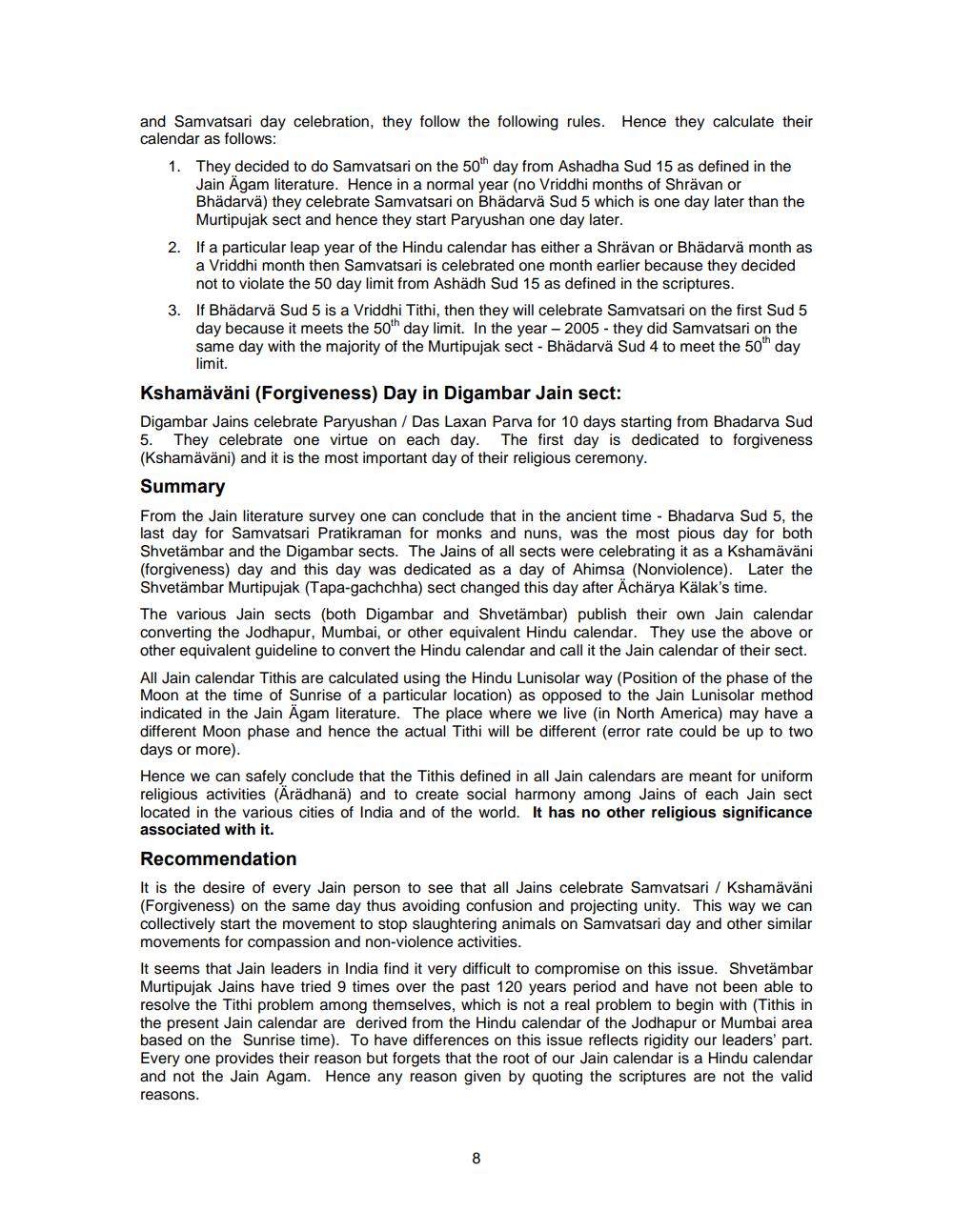Book Title: Samvatsari Tithi Article V4 20120905 Author(s): Pravin K Shah Publisher: JAINA Education Committee View full book textPage 8
________________ and Samvatsari day celebration, they follow the following rules. Hence they calculate their calendar as follows: 1. They decided to do Samvatsari on the 50 day from Ashadha Sud 15 as defined in the Jain Agam literature. Hence in a normal year (no Vriddhi months of Shrävan or Bhädarvä) they celebrate Samvatsari on Bhädarvä Sud 5 which is one day later than the Murtipujak sect and hence they start Paryushan one day later. 2. If a particular leap year of the Hindu calendar has either a Shrävan or Bhädarvä month as a Vriddhi month then Samvatsari is celebrated one month earlier because they decided not to violate the 50 day limit from Ashädh Sud 15 as defined in the scriptures. If Bhädarvä Sud 5 is a Vriddhi Tithi, then they will celebrate Samvatsari on the first Sud 5 day because it meets the 50" day limit. In the year - 2005 - they did Samvatsari on the same day with the majority of the Murtipujak sect - Bhädarvä Sud 4 to meet the 50" day limit. Kshamäväni (Forgiveness) Day in Digambar Jain sect: Digambar Jains celebrate Paryushan / Das Laxan Parva for 10 days starting from Bhadarva Sud 5. They celebrate one virtue on each day. The first day is dedicated to forgiveness (Kshamäväni) and it is the most important day of their religious ceremony. Summary 3. From the Jain literature survey one can conclude that in the ancient time - Bhadarva Sud 5, the last day for Samvatsari Pratikraman for monks and nuns, was the most pious day for both Shvetämbar and the Digambar sects. The Jains of all sects were celebrating it as a kshamäväni (forgiveness) day and this day was dedicated as a day of Ahimsa (Nonviolence). Later the Shvetämbar Murtipujak (Tapa-gachchha) sect changed this day after Acharya Kälak's time. The various Jain sects (both Digambar and Shvetämbar) publish their own Jain calendar converting the Jodhapur, Mumbai, or other equivalent Hindu calendar. They use the above or other equivalent guideline to convert the Hindu calendar and call it the Jain calendar of their sect. All Jain calendar Tithis are calculated using the Hindu Lunisolar way (Position of the phase of the Moon at the time of Sunrise of a particular location) as opposed to the Jain Lunisolar method indicated in the Jain Agam literature. The place where we live in North America) may have a different Moon phase and hence the actual Tithi will be different (error rate could be up to two days or more). Hence we can safely conclude that the Tithis defined in all Jain calendars are meant for uniform religious activities (Aradhana) and to create social harmony among Jains of each Jain sect located in the various cities of India and of the world. It has no other religious significance associated with it. Recommendation It is the desire of every Jain person to see that all Jains celebrate Samvatsari / Kshamäväni (Forgiveness) on the same day thus avoiding confusion and projecting unity. This way we can collectively start the movement to stop slaughtering animals on Samvatsari day and other similar movements for compassion and non-violence activities. It seems that Jain leaders in India find it very difficult to compromise on this issue. Shvetämbar Murtipujak Jains have tried 9 times over the past 120 years period and have not been able to resolve the Tithi problem among themselves, which is not a real problem to begin with (Tithis in the present Jain calendar are derived from the Hindu calendar of the Jodhapur or Mumbai area based on the Sunrise time). To have differences on this issue reflects rigidity our leaders' part. Every one provides their reason but forgets that the root of our Jain calendar is a Hindu calendar and not the Jain Agam. Hence any reason given by quoting the scriptures are not the valid reasons. 8Page Navigation
1 ... 6 7 8 9 10
